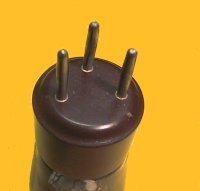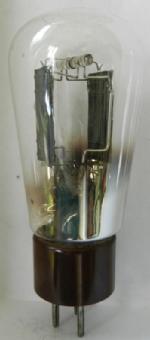
505
|
|
|||||||||||||||||||||||||||||||||||||||||||
|
Klicks: 5717 Antworten: 3
Tube Philips 505 Cine Sonor (.33.)
|
|
|
Georges Van Campenhout † 28.4.22
27.Mar.10 |
1
Dear Radio friends,
I recently received a Philips Tube, model 505. On top of this tube is written (see pictures)
PHILIPS CINE SONOR 505 (.33.)
Inside, one can clearly distinguish two diode systems! I wonder if this is the same tube??
Anlagen
|
|
Jacob Roschy
27.Mar.10 |
2
Hello Georges,
since this tube has merely 3 pins, it can't be anything else then a half-wave rectifier, although two diode systems are visible. It's very likely that you can find a parallel connection inside the tube. I have very little doubt about the correct designation 505. This method was even used in some other cases: have a look at the second picture of the rectifier type 1803 (under “more”) - and you can see a 1803 which is made in the same way. The connection between the two anodes is clearly visible. Best Regards, Jacob
|
|
Georges Van Campenhout † 28.4.22
28.Mar.10 |
3
Thank you, Jacob. Indeed, looking carefully into the glass base shows that the two heaters are connected in series. But what about the other marking: CINE SONOR? Was this rectifier used only for cinema applications? Or is there another explanation?
Best regards
Georges
|
|
Georg Richter
28.Mar.10 |
4
Philips Eindhoven had a "Cine Sonor" department for cinema equipment production (like Siemens had a separate company "Klangfilm"). It may be that Philips tubes which are labeled "Cine Sonor" was sold for a higher price for "dedicated application", similar to the "Klangfilm" tubes which was (often) standard tubes with a different numbering system to prevent cinema operators to use cheaper tubes for replacement. As far as I know the cinema operators had to sign a contract with the cinema equipment supplier. I do not know if those "cinema" tubes has had a higher reliability or was selected for reaching the upper limits of the specifications. If somebody can quote a contract between cinema equipment manufacturers and cinema operators, or can provide data sheets or an advertisement folder of Philips "Cine Sonor" equipment we will know more. Best Regards GR |
Ende Forumsbeiträge zur Röhre
| Datenkonformität | Mehr Informationen |





